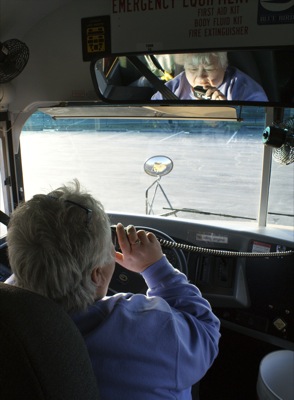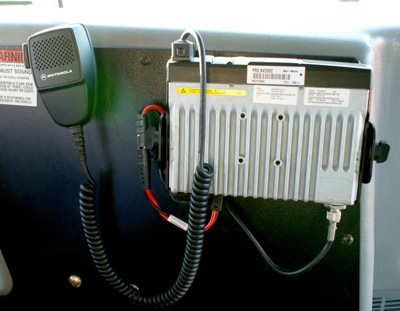Friday, January 6th, 2012
Narrowband order carries big price tag
FCC mandate affects wide range of radio frequency users
By Shelley Grieshop

Photo by Shelley Grieshop/The Daily Standard
Carol Henderson, a longtime bus driver for Celina City Schools, uses one of the radios recently purchased by the district to become compliant with upcoming narrowband regulations.
Public safety and school officials are tapping into already slim budgets to meet the Federal Communications Commission's push to narrowband technology.
The FCC's mandated plan to reduce user bandwidth requires schools to either upgrade handheld and bus radios or totally replace the models if they can't adapt to the new technology. The added expense is an unwelcome burden for school districts already faced with state funding cuts.
Celina schools has shelled out about $11,000 to make the switch and expects a total bill of nearly $23,000 to become fully compliant by the Jan. 1, 2013, deadline. Thirty new radios have been ordered for the district's fleet of 33 buses.
"It's a big chunk of money to lay out, but we have to have communication," said Kevin Mast, the school's business manager.
Tri Star Career Compact recently spent about $6,500 to replace 17 of its handheld radios. No grant funds are available to help with the added expense, Mast said.
The purpose of narrowbanding is to allow additional channels to exist within the same space. The FCC says this will allow more users.
Land mobile radio systems must cease using 25 kilohertz (kHz) efficiency technology and switch to 12.5 kHz. The change also requires frequency users to apply for new FCC licenses. Penalties for noncompliance could include admonishment, monetary fines or loss of licenses, the FCC warned.
Besides schools, the mandate affects UHF and VHF frequency bands used by 911 dispatchers, firefighters and paramedics, utility and street crews and some private sector businesses. It also applies to the operation of tornado sirens.
Celina Fire Chief Doug Wolters began preparing for the narrowband mandate months ago for his department and other emergency response agencies throughout the county.
"We've bought a lot of new pagers the last few years to prepare for this," he said.
Newer pagers used by firefighters and paramedics are being upgraded at a cost of about $25 per unit, he added. Most of the 250 radios currently in use by county public safety departments already have been updated or replaced.
Officials haven't calculated the total countywide cost to meet the FCC order. Like school districts, counties and municipalities also are dealing with a 25 percent cut in local government funding this year and again in 2013.
The switch to narrowband should be seamless for the sheriff's department - including Central Dispatch - since its radios are linked to the Multi-Agency Radio Communications System (MARCS), which adapts easily to narrowband, 911 Administrator Monte Diegel said.
The sheriff's office likely will dish out less than $500 to adjust its equipment, he added.
"There are a few (county) agencies that still use their old VHF radio equipment to communicate with neighboring county agencies, so those radios will need to be narrowbanded," he said.
Central Dispatch and most county agencies will make the switch to narrowband Feb. 23 and 24 with the help of private sector communication experts, Diegel said.
"We've had a good number of meetings over the last 18 months or so with everyone involved in order to get ready for this move," he said
Mercer County Commissioners this week met with EMA Director Mike Robbins to discuss replacement of a 100-watt base station in the courthouse basement, which is used to activate the county's outdoor warning siren system. The equipment cannot be upgraded to narrowband and will be replaced with a unit from the county's communications and hazardous material response vehicle, Robbins said.
The cost for the project will be about $3,000, but grant funding is available, he noted.

Photo by Shelley Grieshop/The Daily Standard
One of the recently purchased radios in a Celina City Schools' bus. The district purchased new radios to become compliant with upcoming narrowband regulations.



